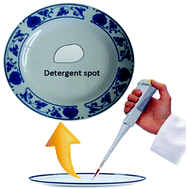Detection of domestic detergent residues on porcelain tableware using laser induced breakdown spectroscopy
Abstract
Domestic detergents are widely used and the detection of detergent residues on tableware is closely related to people's health. As is known to all, it is difficult to sample and measure the residual detergent on tableware. The purpose of this paper is to explore a rapid in situ detergent residues detection method. We have using laser-induced breakdown spectroscopy (LIBS) measured the detergent on porcelain plate. Based on our previous research, we further studied the spectra of detergent in argon atmosphere, and compared them with that in air. We found the spectral characteristics of the cyanogroup (CN) were related to the air around the measuring point. It was indicated that CN could not as previously speculated be used as the LIBS detection feature of detergent. The improvement of signal-to-noise ratio (SNR) in argon environment was proved and we made a study of semi quantitative measurement by the peak height of 330.30 nm in argon atmosphere. An experiment measuring the detergent on tableware after washed was taken. It illustrated that the LIBS technology has promising potential applications for tableware cleaning process or food production process as a means of on-line detection.



 Please wait while we load your content...
Please wait while we load your content...